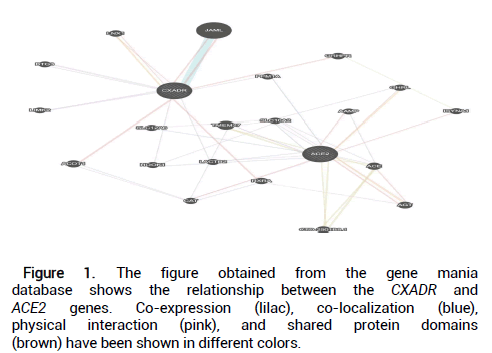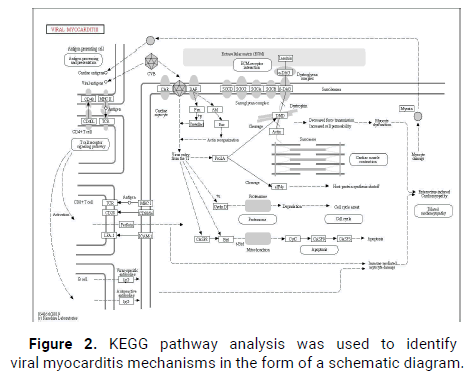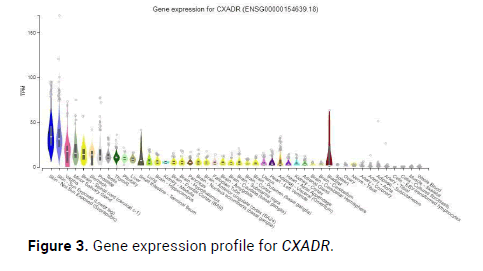Research Article - (2023) Volume 5, Issue 1
Background/aim: Some viral infections cause myocarditis. Since myocarditis and Coronavirus show similar symptoms (such as chest pain), it is important to distinguish between these two diseases, both in determining the treatment to be applied and in preventing the disease. This study aims to demonstrate the potential clinical significance of CXADR and ACE2 in COVID-19 using an in silico approach.
Materials and methods: In this study, STRING and GENEMANIA databases were used to understand similarities between CXADR gene and ACE2. KEGG pathway was used to analysis of viral myocarditis. Exome variant server and polyphen2 database were used to find probably damaging SNPs on the CXADR gene and it was shown where the CXADR gene was expressed by UCSC Genome Browser, Ensembl Genome Browser, and IGV Browser.
Results: It was shown that CXADR expression is associated with PPM1A, SLC10A2, TMEM27, LACTB2, RXRA, SLC12A6, and HOOK1, and CXADR is highly expressed in skin, bladder, brain, stomach, prostate, and testis. In addition, eleven potentially deleterious SNPs have been identified in the CXADR gene.
Conclusion: This study shows that there is a relationship between CXADR and ACE2 and that ACE2 may have a role in myocardial damage.
Myocardial damage • Disease • Hypertension • Syndrome • Chronic lung disease
COVID-19 is a pandemic disease that shows different symptoms from other upper respiratory tract infections. Also, the progression in severity and duration of the disease depends on the patient's clinical history. It is a potentially fatal disease with clinical manifestations ranging from mild respiratory distress to severe acute respiratory distress syndrome. COVID-19 has caused 636 million cases and more than 6.6 million deaths globally. Common comorbidities of COVID-19 include heart failure, arrhythmias, hypertension, diabetes, renal failure, and chronic lung disease. The clinical spectrum of human infection with SARSCoV- 2 is not fully understood, but researchers still continued to study and understand its pathogenesis. Furthermore, as with other respiratory infections, pre-existing cardiovascular disease and risk factors can increase the severity of COVID-19, leading to worsening and decompensation of underlying chronic heart disease and new acute cardiac complications [1].
ACE2 (Angiotensin Converting Enzyme 2) is identified as a multifunctional transmembrane protein recognized as the entry receptor of the virus that causes COVID-19. ACE2 is expressed in many different tissues and is particularly highly expressed in these organs when SARS-CoV-2 infects host cells. High levels of ACE2 protein expression have been connected with an increased risk of serious infections and complications in COVID-19 disease. Originally discovered that the Coxsackievirus Adenovirus Receptor (CAR) is a cell surface protein that enables both viruses to interact with cells, the physiological role of CAR is principally unknown. Current studies have shown that the regulation of CAR expression on cardiomyocytes has been identified. Weak expression or absence of CAR on adult and normal cardiac cardiomyocytes compared to high CAR expression on developing and diseased cardiac cardiomyocytes can indicate a part of CAR in functional cardiomyocytes. Myocarditis is an important complication that physicians are afraid of the occurrence in patients with COVID-19. Myocarditis is inflammation of the muscular part of the heart, mostly caused by viruses. Myocarditis can result from autoimmunity triggered by a viral infection, a pathological immune response to the virus, or the cytopathic effects of the virus. There is little data on how to diagnose myocarditis during COVID-19. Furthermore, information about prevalence and prognosis is insufficient, and it is unclear whether myocarditis is an indirect complication of the disease or a direct cardiac manifestation of the virus. Similar symptoms such as shortness of breath and fever between patients with COVID-19 and myocarditis make the diagnosis of the two diseases almost indistinguishable. Understanding this confusion is important for treatment. In this study, our aim is to explain the relationship between the CXADR (CXADR Ig like cell adhesion molecule) gene and ACE2 in COVID-19 [2].
The web based software used in this study was entered between 9 February-23 Ekim 2022.
CXADR gene dataset collection
Information on the CXADR gene was collected from different websites such as Online Mendelian Inheritance in Man (OMIM) and Antre gene on National Center for Biological Information (NCBI). Moreover, protein accession number and SNP ID were found by The Single Nucleotide Polymorphism (SNPs) information and SWISS Prot databases were used to collect information about the protein sequence of CXADR. These bioinformatics websites were used to contribute to the pathogenesis of CXADR and to understand the connections between viral myocarditis and COVID-19 [3].
Finding genes similar to the CXADR gene and viral myocarditis pathway analysis
GeneMANIA and STRING databases help to investigate the connection between the gene you have chosen and other genes. These databases evaluates the genomic, proteomic, and biological data of the chosen gene. Connections between the CXADR gene and the ACE2 gene were demonstrated using these databases. Then our results were compared with a literature search. KEGG is a database that describes genomes, biological pathways, diseases, medicine, and chemical materials, and pathway analysis of viral myocarditis was found using the KEGG database [4].
Probably damaging SNPs on the CXADR gene and prediction of the expression level of the CXADR gene
Prediction of the expression level of the CXADR gene was used by IGV Browser, Ensembl Genome Browser, and UCSC Genome Browser. It was used to discover the expression level of CXADR. Thus, all results were verified with each other and the GTEx portal. Possibly harmful SNPs on the CXADR gene were defined by Exome Variant Server (EVS) and PolyPhen2 databases these databases support finding SNPs on genes. Our results confirmed each other [5-12].
In our study, we examined the CXADR gene and tried to clarify the relationship between viral myocarditis and the ACE2 gene, and then we defined some genes associated with the CXADR gene (Figure 1).

Figure 1: The figure obtained from the gene mania database shows the relationship between the CXADR and ACE2 genes. Co-expression (lilac), co-localization (blue), physical interaction (pink), and shared protein domains (brown) have been shown in different colors.
Then we investigated polymorphisms on the CXADR gene, and we found 78 variations in European American and African American populations on the CDXADR gene, and 11 of them found to have suspicious polymorphisms on the CXADR gene (Table 1) [13-16]. Moreover, we have shown the pathway of viral myocarditis in Figure 2.
| rs ID | Alleles | EA genotype | AA genotype | GVS function | PolyPhen2 (Class: Score) |
|---|---|---|---|---|---|
| rs370215404 | C>T | T=1/C=8599 | T=0/C=4406 | Missense | Probably-damaging: 0.998 |
| rs374465561 | C>A | A=1/C=8599 | A=0/C=4406 | Missense | Probably-damaging: 0.999 |
| rs368675196 | C>T | T=0/C=8600 | T=1/C=4405 | Missense | Probably-damaging: 0.995 |
| rs370613074 | A>G | G=0/A=8596 | G=1/A=4405 | Missense | Probably-damaging: 1.0 |
| rs377175208 | A>G | G=0/A=8600 | G=1/A=4405 | Missense | Possibly-damaging: 0.565 |
| rs370031613 | G>A | A=0/G=8600 | A=1/G=4405 | Missense | Probably-damaging: 1.0 |
| rs372541602 | A>G | G=0/A=8600 | G=1/A=4405 | Missense | Probably-damaging: 0.959 |
| rs138470268 | C>T | T=1/C=8599 | T=0/C=4406 | Missense | Possibly-damaging: 0.955 |
| rs376434359 | G>A | A=0/G=8600 | A=1/G=4405 | Missense | Possibly-damaging: 0.907 |
| rs142651712 | C>T | T=1/C=8599 | T=103/C=4301 | Missense | Probably-damaging: 1.0 |
| rs149825627 | G>C | C=0/G=8584 | C=1/G=4401 | missense | probably-damaging: 0.999 |
Table 1. This table has shown that suspicious polymorphisms of CXADR gene.

Figure 2: KEGG pathway analysis was used to identify viral myocarditis mechanisms in the form of a schematic diagram.
Then we showed gene expression for the CXADR gene, and our results have indicated that it is highly expressed in the skin, bladder, brain, stomach, prostate, and testis in Figure 3 [17-19].

Figure 3: Gene expression profile for CXADR.
Myocarditis is cs inflammation or infection of muscle in the heart, and it can occur with different clinical pictures while determining its incidence is very difficult. Some viruses, various microorganisms, collagen tissue diseases, rheumatic fever, Kawasaki diseases, and many drugs can cause myocarditis. CAR is a protein that expresses in various mammalian tissues such as the heart, brain, lung, testis, epithelial and endothelial cells and it is encoded by the CXADR gene. Identifying the kinetics of the disease is very important for the regulation of CAR. In our study, we evaluated the CXADR gene and we tried to explain the relationship between viral myocarditis and the ACE2 gene, then we identified many genes associated with the CXADR gene but we thought that the most important of these are ACE2, AGT, and ACE. It is very important for understanding the kinetics of the disease. One of the most important reasons for myocarditis is viral in the United States and other developed countries. We thought that viral myocarditis may be due to cytopathic consequences of the virus, autoimmunity stimulated by a viral infection, or a pathological immune response to a persistent virus. Symptoms of COVID-19 and myocarditis show similar features (such as shortness of breath and fever). To distinguish between two diseases is very important to treat them correctly. Therefore, we studied the relationship between the CXADR gene and ACE2 in our study. Recent studies have shown that myocardial injury have a relationship with COVID-19. ACE2 is a membrane bound protein that has a significant role in the pathophysiology of cardiovascular diseases and it is expressed in lung tissues, cardiovascular epithelium, and renal tissue as it is a member of the Renin-Angiotensin System (RAS). SARS-CoV-2 binds to the host of the ACE2 receptor for entry into the cells. ACE2 may be revealed on the ciliated columnar epithelial cells of the respiratory tract, type II pneumocytes, and cardiomyocytes. Thus, if ACE2 is up regulated, it can cause infection of the human heart by SARSCOV- 2. SARS-CoV-2 has caused the death of further than 6.6 million people worldwide. The pathophysiology of the coronavirus has not been fully elucidated Genetic polymorphisms are suspicious in most diseases and heritable factors can play role in infectious diseases such as influenza virus, hemorrhagic fever virus, and coxsackievirus. In our study, 7 similar genes were linked to ACE2 and CXADR genes. These are PPM1A, SLC10A2, TMEM27, LACTB2, RXRA, SLC12A6, and HOOK1. While there was a study showing the relationship between TMEM27 and SLC12A6 with COVID-19 in the literature, there was no study showing the relationship with myocarditis. Also, there were no studies of both COVID-19 and myocardial related genes PPM1A, SLC10A2, LACTB2, RXRA, and HOOK1. This is the first study in the literature that shows the link between ACE2 and CXADR regarding on COVID-19. Thus, we think that this information can contribute to solving the complex pathogenesis of COVID-19. We found that the CXADR gene is highly expressed in the brain, skin, stomach, bladder, testis, and prostate. In case of an increase or decrease in this expression level, it can affect the mechanisms related to COVID-19 we identified 11 suspected SNPs in the CXADR gene. The SNPs we have detected may affect the production or function of a protein and thus improve differential diagnosis and optimize treatment efficacy in COVID-19 patients [20].
ACE2 can contribute to myocardial injury, and cytokine storms may be responsible for many observed mechanisms and manifestations. This is the first study to explain the link between ACE2 and CXADR in COVID-19. We believe our results will guide in vitro and in vivo studies to elucidate the pathogenesis of ACE2 and CXADR in COVID-19.
• Conception: Duygu Kirkik.
• Design: Duygu Kirkik, Fatih Hacimustafaoglu, Ersin Ibisoglu.
• Supervision: Duygu Kirkik, Fatih Hacimustafaoglu, Ersin Ibisoglu.
• Data collection and/or processing: Duygu Kirkik, Fatih
Hacimustafaoglu, Ersin Ibisoglu.
• Literature review: Duygu Kirkik, Fatih Hacimustafaoglu.
• Writer: Duygu Kirkik.
• Critical review: Duygu Kirkik, Fatih Hacimustafaoglu.
The authors declare that there is no conflict of interest.
[Crossref] [Google Scholar] [PubMed]
[Crossref] [Google Scholar] [PubMed]
[Crossref] [Google Scholar] [PubMed]
[Crossref] [Google Scholar] [PubMed]
[Crossref] [Google Scholar] [PubMed]
[Crossref] [Google Scholar] [PubMed]
[Crossref] [Google Scholar] [PubMed]
[Crossref] [Google Scholar] [PubMed]
[Crossref] [Google Scholar] [PubMed]
[Crossref] [Google Scholar] [PubMed]
[Crossref] [Google Scholar] [PubMed]
[Crossref] [Google Scholar] [PubMed]
[Crossref] [Google Scholar] [PubMed]
[Crossref] [Google Scholar] [PubMed]
[Crossref] [Google Scholar] [PubMed]
[Crossref] [Google Scholar] [PubMed]
[Crossref] [Google Scholar] [PubMed]
[Crossref] [Google Scholar] [PubMed]
[Crossref] [Google Scholar] [PubMed]
[Crossref] [Google Scholar] [PubMed]
Citation: Kirkik D, et al. "Potential Clinical Significance of CXADR on COVID-19". J Microbiol Immunol, 2023, 5(1), 1-4.
Received: 23-Feb-2023, Manuscript No. JMBI-23-89912; Editor assigned: 27-Feb-2023, Pre QC No. JMBI-23-89912 (PQ); Reviewed: 13-Mar-2023, QC No. JMBI-23-89912; Revised: 28-Apr-2023, Manuscript No. JMBI-23-89912 (R); Published: 05-May-2023, DOI: 10.4172/JMBI.23.5(1).03
Copyright: © 2023 Kirkik D, et al. This is an open-access article distributed under the terms of the Creative Commons Attribution License, which permits unrestricted use, distribution, and reproduction in any medium, provided the original author and source are credited.